You’ll discover that historical appraisal techniques evolved from ancient Egyptian methods evaluating sacred ornaments through five criteria—materials, symbolism, craftsmanship, ritual appropriateness, and purity—to sophisticated Mesopotamian touchstone testing and fire assay methods for metal authentication. Greeks and Romans developed gemstone evaluation through visual inspection and early magnification, while medieval guilds established rigorous hallmarking standards. These foundational approaches ultimately transformed into today’s scientific precision methods that’ll reveal fascinating cultural insights about ancient civilizations.
Ancient Egyptian Methods of Evaluating Sacred Ornaments
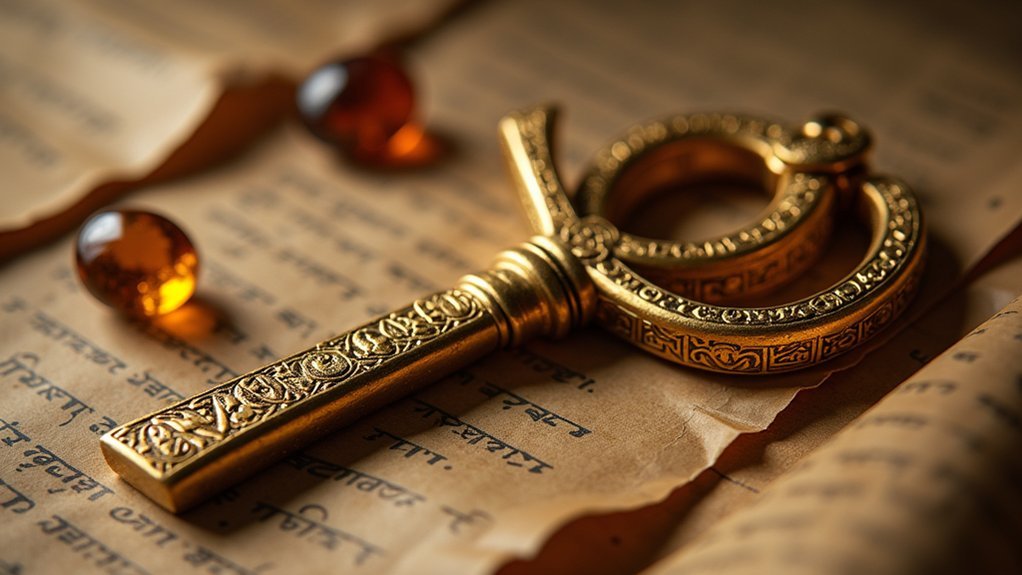
When you examine ancient Egyptian sacred ornaments, you’ll discover that their evaluation system centered on five critical elements that determined both spiritual and material worth.
You’d first assess the materials, particularly gold, which they prized for its connection to Ra and protective powers.
Next, you’d analyze symbolic meanings embedded in motifs like scarabs and lotus flowers, each carrying specific spiritual significance.
The craftsmanship quality revealed the artisan’s skill and the wearer’s social standing through intricate designs.
You’d also consider ritual appropriateness, determining whether pieces suited burial ceremonies for afterlife protection.
Finally, you’d measure weight and purity against established standards to verify authenticity and establish trade value in ceremonial contexts.
Mesopotamian Techniques for Assessing Precious Metalwork
You’ll find that Mesopotamian artisans developed sophisticated authentication methods that went far beyond basic visual inspection of precious metalwork.
They’d employ the touchstone method to test metal purity and inscribe standardized weights directly onto pieces to verify authenticity.
These techniques weren’t just about determining monetary value—they established symbolic worth through hallmarking systems that certified both the metal’s quality and the artisan’s reputation.
Ancient Authentication Methods
Although modern technology has revolutionized how we authenticate precious metals, ancient Mesopotamian craftsmen developed remarkably sophisticated methods that laid the foundation for today’s appraisal techniques.
You’ll find that these ancient civilizations created the touchstone method, where artisans rubbed metal against stone to assess purity through streak colors. They’d also weigh precious metals using standardized scales, establishing consistent measurement protocols that enhanced jewelry making precision.
You’d witness craftsmen employing fire assay techniques, heating samples to separate impurities for accurate purity determination. They developed hallmark systems featuring specific symbols representing different city-states renowned for metalwork excellence.
Most importantly, you’d observe how experienced jewelers relied on visual inspection and extensive knowledge of local materials and trade sources to authenticate precious adornments effectively.
Symbolic Value Assessment
Beyond material purity, Mesopotamian artisans recognized that a piece’s true worth extended far into the domain of symbolic significance, where intricate designs and sacred motifs determined social standing and spiritual protection.
You’d assess symbolic value by examining the complexity of patterns, religious iconography, and cultural references embedded within precious metals. Cuneiform inscriptions revealed ownership, provenance, and intended purpose, directly impacting the piece’s historical importance.
When evaluating gemstones, you’d consider their specific meanings—certain stones carried divine attributes or protective powers that enhanced the jewelry’s spiritual worth.
The combination of precious metals with strategically chosen gemstones created layers of meaning that transcended mere monetary value, establishing the wearer’s identity and beliefs within Mesopotamian society.
Greek and Roman Approaches to Gemstone Authentication
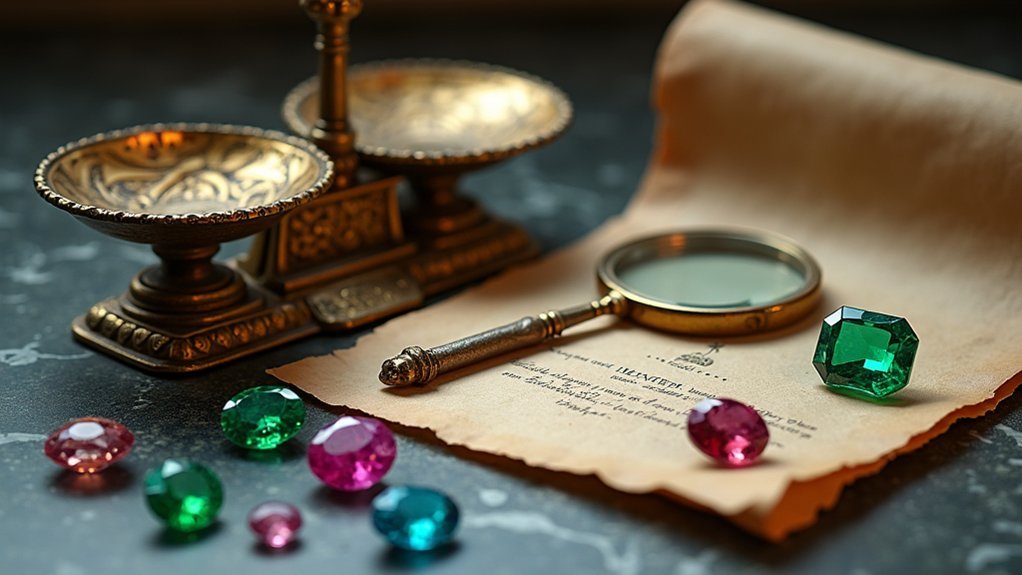
When examining the ancient world’s approach to gemstone evaluation, you’ll discover that Greek and Roman civilizations developed sophisticated methods that formed the foundation of modern appraisal techniques.
You’d find Greeks employing visual inspection and tactile assessment, focusing on clarity, color, and size to verify authenticity. They used simple magnifying glasses to detect inclusions and imperfections, ensuring quality standards were met.
Romans advanced these practices by implementing regulations against counterfeit stones, requiring sellers to provide documentation proving provenance.
You’ll notice their emphasis on craftsmanship quality, particularly in rings and cameos where artisans signed their work for verification.
Most notably, Romans developed hallmarking systems to mark authentic gemstones and precious metals, establishing practices that directly influenced today’s appraisal methods.
Medieval Guild Standards for Jewelry Examination
You’ll find that medieval guilds revolutionized jewelry appraisal through rigorous certification methods that authenticated each piece’s origin and quality.
They established stringent metal purity standards, requiring hallmarks that verified the exact content of gold and silver used in every creation.
These organizations also developed thorough craftsman skill rankings that determined who could examine and appraise different types of jewelry based on their proven expertise.
Guild Certification Methods
Since medieval guilds controlled the jewelry trade with iron-fisted precision, they developed extensive certification methods that transformed how precious adornments were evaluated and verified.
You’d find these rigorous systems guaranteed only legitimate artisans could operate in the marketplace.
The guild’s certification methods created an unbreakable chain of trust through:
- Hallmarking stamps – Your piece received permanent symbols indicating metal purity and craftsman identity
- Mandatory apprenticeships – You couldn’t practice without years of training under experienced professionals
- Master craftsman evaluations – You’d face grueling tests proving your expertise before certification
These quality standards weren’t suggestions—they were law.
Guild officials conducted regular inspections, hunting down counterfeit jewelry and substandard work.
If you violated regulations, you’d face severe penalties that could destroy your livelihood and reputation permanently.
Metal Purity Standards
Medieval guilds revolutionized jewelry authentication by establishing precise metal purity standards that protected both craftsmen and customers from fraud.
You’ll find that gold jewelry was measured using the karat system, where 24 karats represented pure gold, while practical jewelry typically ranged from 10 to 18 karats. Silver required at least 92.5% purity to earn the sterling mark, becoming Europe’s accepted standard.
When you examine medieval pieces, you’re seeing the results of rigorous testing by guild assayers who used fire assays to verify metal purity.
Hallmarking became your guarantee of authenticity—unique stamps identified the maker, metal quality, and responsible guild.
These standards weren’t just regulations; they’re the foundation that built consumer confidence in precious metal jewelry that continues today.
Craftsman Skill Rankings
When medieval guilds established their hierarchical craftsman skill rankings, they created a meritocratic system that assured only the most skilled artisans could examine and authenticate precious jewelry.
You’ll find this structure guaranteed exceptional quality standards through rigorous testing and continuous oversight.
The guild system’s emotional impact on craftsmen included:
- Pride – Master status represented years of dedication and uncompromising excellence
- Security – Guild membership provided protection and assured livelihood for skilled artisans
- Legacy – The apprenticeship program allowed masters to pass down centuries-old techniques
You’d witness regular inspections where guild officials scrutinized every detail of workmanship.
Failure meant devastating consequences: hefty fines or complete expulsion from the guild.
This relentless pursuit of perfection created jewelry appraisal standards that remained unmatched for centuries.
Renaissance Advancements in Precious Metal Testing
Three revolutionary testing methods transformed how Renaissance artisans evaluated precious metals, marking a decisive shift from medieval guesswork to scientific precision.
You’d find Renaissance jewelers employing touchstone techniques, acid testing, and refined assay methods to determine gold and silver content accurately. These advancements weren’t just technical improvements—they revolutionized trade by enabling fair pricing and proper taxation of precious metals.
| Testing Method | Primary Use | Key Advantage |
|---|---|---|
| Touchstone | Quick purity assessment | Immediate results |
| Acid Testing | Chemical verification | High accuracy |
| Aqua Regia | Gold dissolution test | Definitive proof |
Official assay offices emerged across regions, standardizing precious metal evaluation and fostering marketplace trust. Artisans began incorporating specific hallmarks to denote quality, giving you confidence in their metalwork’s authenticity and enhancing the overall credibility of the precious metals trade.
Early Hallmarking Systems and Quality Verification
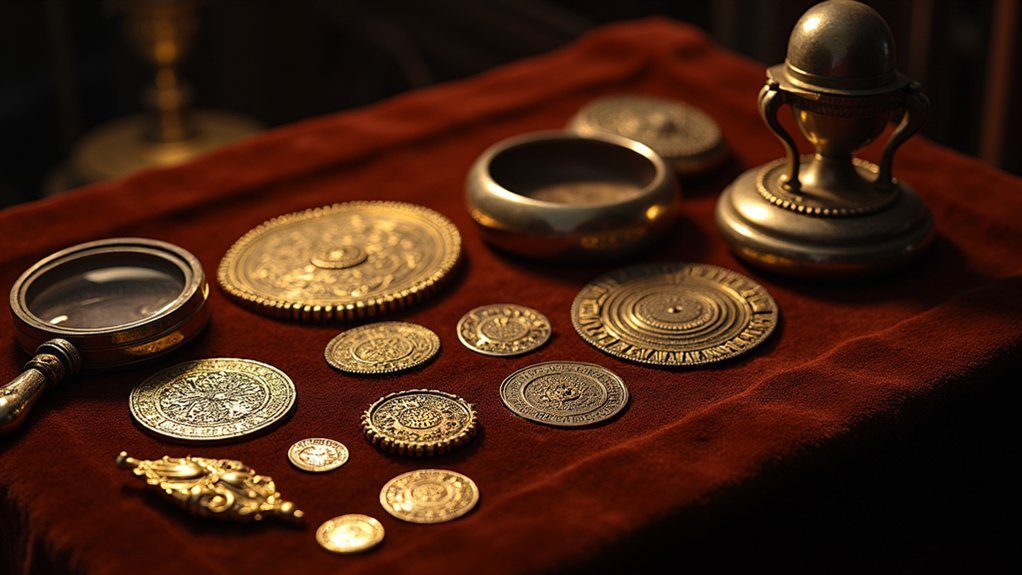
As Renaissance testing methods established scientific accuracy, England’s 14th-century hallmarking system created the first extensive framework for guaranteeing precious metal quality.
This revolutionary approach to quality verification transformed how you’d identify authentic precious metals in the marketplace.
When examining hallmarked pieces, you’ll discover three essential symbols that reveal a jewelry’s complete story:
- The maker’s mark – your direct connection to the craftsman’s identity and reputation
- Fineness numbers (like 925 for sterling silver) – your guarantee of metal purity and value
- Date letters – your window into the piece’s historical timeline and provenance
France later enhanced hallmarking systems in the 18th century, introducing distinctive symbols like seahorses for gold and Minerva for silver.
Today, you’ll find hallmarks required on jewelry exceeding 3 grams, ensuring authenticity before sale.
Traditional Visual Inspection Methods for Gemstones
Beyond verifying metal authenticity through hallmarks, you’ll need to master the art of gemstone evaluation through traditional visual inspection methods.
Using a x10 magnifying loupe, you’ll examine clarity, inclusions, and surface characteristics that directly impact quality assessment. Your detailed visual inspection should evaluate color intensity, size, shape, and any visible imperfections essential for accurate valuation.
You’ll measure dimensions with calipers to calculate volume, then determine weight using precision scales for exact carat measurements.
Assess cut quality by examining symmetry and light reflection, which determine brilliance and aesthetic appeal.
During your inspection of gemstones, identify manufacturing techniques and historical markers that help date the piece and establish origin, providing vital context for thorough valuation.
Historical Weight and Measurement Techniques
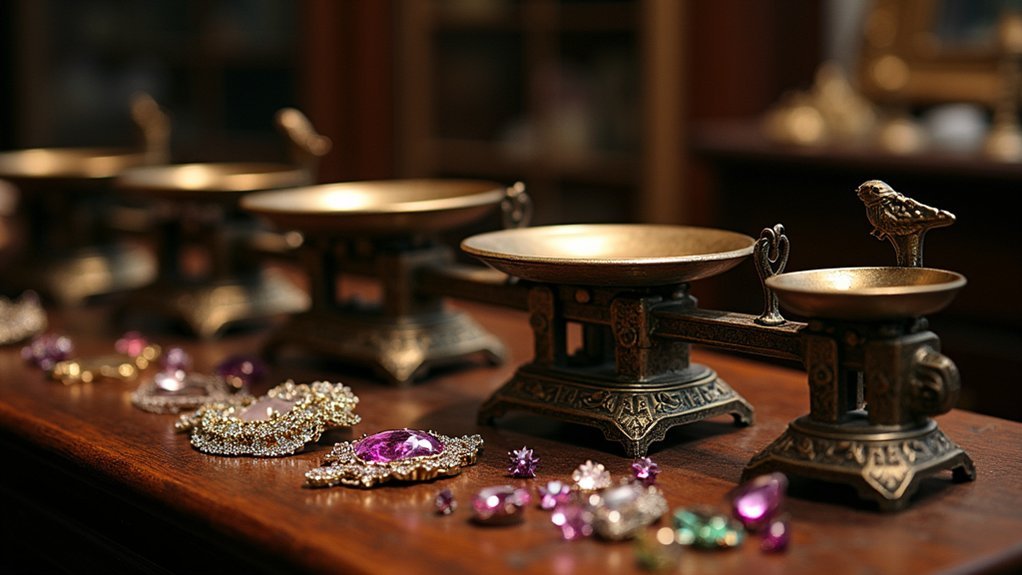
You’ll find that ancient civilizations developed sophisticated weighing systems using balance scales and standardized units like stones or metals to determine the value of precious adornments.
These early methods evolved from simple comparisons to precise measurements, with the carat system originating from carob seeds that provided consistent weight references.
As precision scale technology advanced, jewelers gained the ability to measure not just weight but also volume and density, enabling more accurate assessments of both authenticity and purity.
Ancient Weighing Systems
Throughout ancient civilizations, precise weighing systems formed the backbone of jewelry appraisal, with each culture developing sophisticated methods to determine the value of precious adornments.
You’ll find fascinating diversity in these ancient approaches to valuing precious metals and gemstones.
The Mesopotamians pioneered the shekel system, weighing approximately 11.3 grams, serving dual purposes as currency and measurement standard.
Egyptians utilized the deben, equivalent to 91 grams, specifically for evaluating gold and silver jewelry weight.
Romans standardized their libra at 327 grams, facilitating empire-wide trade consistency.
These weighing systems revolutionized commerce through:
- Standardized measurements that eliminated merchant disputes and built consumer trust
- Precise valuations that protected both buyers and sellers from financial loss
- Enhanced trade relationships that fostered economic growth across civilizations
Balance scales like steelyard instruments guaranteed accuracy, making these ancient systems remarkably sophisticated.
Precision Scale Evolution
Four millennia of innovation transformed simple balance scales into today’s sophisticated digital instruments, fundamentally changing how jewelers measure and value precious adornments.
You’ll find that ancient civilizations first developed balance scales specifically for weighing precious metals and gemstones with remarkable accuracy. During medieval times, improved metallurgy allowed craftsmen to create more refined scales, giving you greater precision and reliability when weighing valuable goods.
The 18th century brought spring scales, offering you enhanced portability and ease of use.
However, the 19th century’s electronic revolution truly transformed the jewelry industry. These digital precision scales provided you with instant readouts and unprecedented accuracy.
Today’s instruments measure in standardized units—carats, grams, and ounces—ensuring you can consistently evaluate precious adornments with professional-grade precision.
Pre-Industrial Tools for Material Analysis
Five fundamental tools formed the backbone of pre-industrial jewelry appraisal, each serving a distinct purpose in analyzing precious materials.
You’d rely on magnifying glasses and handheld lenses to inspect gemstones for imperfections, while balance scales provided vital weight measurements for determining authenticity.
Acid tests became your go-to method for evaluating gold and silver purity, as different acids would react uniquely based on the materials used.
The emotional weight of these pre-industrial tools reveals itself through:
- Trust – Your livelihood depended on accurately identifying genuine stones
- Pride – Mastering these techniques separated skilled artisans from amateurs
- Legacy – Each appraisal connected you to generations of craftsmen
Your keen observational skills and tactile evaluations completed the jewelry evaluation process, compensating for technology’s absence.
Evolution of Craftsmanship Assessment Methods
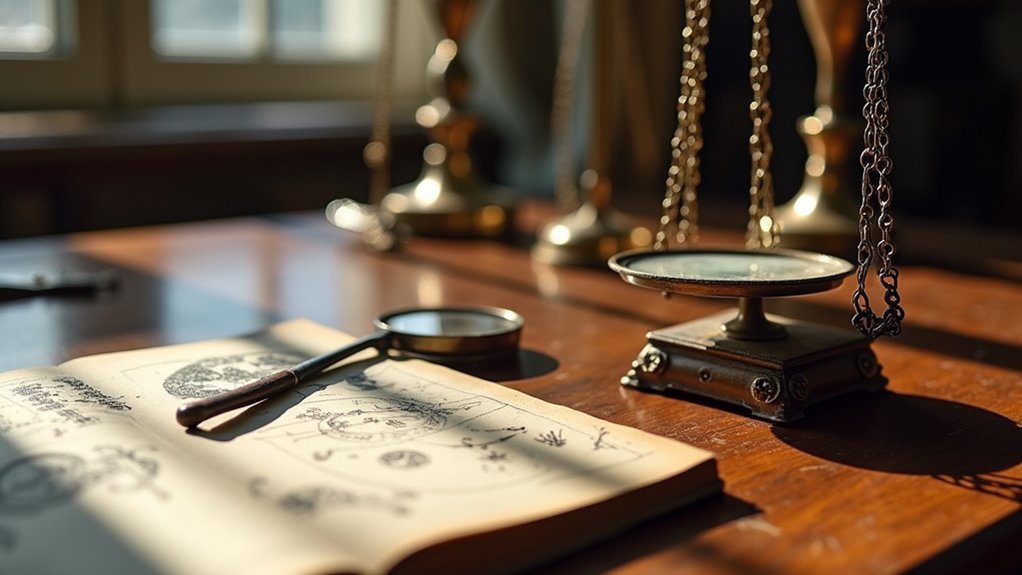
As jewelry craftsmanship grew more sophisticated beyond basic material identification, appraisal methods had to adapt accordingly.
During the Renaissance, you’d witness artisans developing advanced gemstone cutting and setting techniques that fundamentally changed how craftsmanship quality was evaluated. These innovations forced appraisers to assess intricacy and precision rather than just material value.
Renaissance innovations shifted jewelry appraisal from simple material assessment to evaluating the sophisticated artistry and technical precision of gemstone craftsmanship.
The 14th century’s hallmarking introduction revolutionized your ability to verify precious metal authenticity, standardizing quality assessments across markets.
You’ll find that modern appraisals now incorporate historical context analysis, examining manufacturing techniques and design motifs to determine provenance.
Today’s technological advances, including 3D printing and CAD systems, allow you to evaluate incredibly intricate designs with unprecedented precision, transforming how craftsmanship is both created and assessed in contemporary gemstones and jewelry markets.
Cultural Context and Provenance Evaluation
When you’re evaluating jewelry, understanding its cultural context and provenance becomes just as essential as appraising its physical properties.
Provenance evaluation involves tracing an artifact’s complete history—from origin through ownership and exhibition records—which directly impacts authenticity determinations and market value.
Cultural context reveals how designs, materials, and usage patterns reflect the artistic and socioeconomic conditions of their creation period.
However, you’ll encounter significant challenges:
- Heartbreaking gaps in documentation leave countless ancient pieces without controlled excavation records
- Devastating uncertainty surrounds authenticity when provenance chains break
- Profound responsibility weighs on curators to practice full disclosure about origins
You must distinguish between documented excavations and unexcavated sources, ensuring visitors understand these vital authenticity markers that shape cultural narratives.
Traditional Documentation and Record-Keeping Practices
Meticulous documentation forms the backbone of professional jewelry appraisal, requiring you to maintain thorough records that extend far beyond simple value estimates.
You’ll need to catalog each piece’s provenance, tracing its origin, ownership history, and cultural significance through historical records like auction catalogs and sales receipts.
Your reports must include detailed photographs capturing every angle, extensive descriptions of materials and craftsmanship, and documentation of hallmarks or markings that verify authenticity.
Professional appraisal demands comprehensive visual documentation, detailed material analysis, and careful recording of all identifying marks to establish authenticity.
When evaluating gemstones, you’ll use standardized forms recording the four Cs—carat, color, clarity, and cut—ensuring consistent valuation methods.
This extensive documentation doesn’t just support accurate appraisal; it enhances the piece’s marketability and provides essential authenticity verification for future buyers and collectors.
Early Market Valuation Approaches
You’ll find that early civilizations established sophisticated valuation systems centered on precise weight measurements, with merchants using standardized scales to determine the worth of gold and silver ornaments based on mass and metal purity.
Ancient weight standards varied across regions, but they consistently provided the foundation for fair trade by creating universally understood units of measurement.
Temple authentication methods emerged as religious institutions began certifying precious items, lending their authority to validate both the quality and spiritual significance of valuable adornments.
Ancient Weight Standards
Long before modern gemological laboratories established precise grading systems, ancient merchants relied on standardized weight measures to determine the value of precious adornments in bustling marketplaces.
You’d find Mesopotamian traders using shekels to assess precious metals and gemstones, while Egyptian merchants weighed gold against the deben unit.
Romans revolutionized the process by creating coinage systems with fixed exchange rates based on weight and purity.
These ancient weight standards created emotional connections through:
- Trust – Standardized measures built confidence between traders across vast distances
- Security – Balance scales provided visible proof of fair transactions
- Legacy – The carat system, originating from carob seeds, still influences today’s gemstone valuations
Different cultures developed unique standards, establishing the foundation for modern appraisal techniques.
Temple Authentication Methods
As civilizations evolved beyond simple weight-based trading, temples emerged as sophisticated centers where religious authority merged with commercial expertise to authenticate precious adornments.
You’ll find that priests evaluated jewelry using specific criteria including metal purity, craftsmanship quality, and the presence of gemstones believed to possess divine attributes. These religious institutions employed skilled artisans and early gemologists who’d assess authenticity before accepting items for trade or offerings.
Temples established the first hallmarking systems, creating certification methods that denoted quality and guaranteed authenticity.
You’d witness how these sacred marketplaces regulated jewelry trade, directly influencing market values through religious and cultural perceptions of worth. This temple-based authentication system laid the foundation for modern appraisal techniques, proving that spiritual authority and commercial validation were inseparably linked in ancient economies.
Transition to Modern Scientific Appraisal Methods
While traditional jewelry appraisal relied heavily on visual inspection and basic tools, the evolution toward modern scientific methods has revolutionized how you’ll assess precious adornments today.
You’ll now utilize advanced technologies like spectroscopy and laser measurements to determine precise composition and quality of gemstones and metals.
Modern appraisal methods incorporate sophisticated instruments that’ll transform your evaluation process:
- Refractometers and polariscopes – You’ll analyze light properties to authenticate gemstones beyond what your eyes can detect.
- X-ray fluorescence and scanning electron microscopy – You’ll conduct non-destructive testing on delicate antique jewelry.
- Standardized grading systems – You’ll apply consistent frameworks like the “4 Cs” for reliable assessments.
These scientific approaches integrate digital databases and archival research, ensuring you’ll understand both material composition and historical provenance.
Frequently Asked Questions
Which Ancient Civilization Is Credited With Being the First to Incorporate Gemstones Into Jewelry?
You’ll find that ancient Egyptians were the first civilization to incorporate gemstones into jewelry around 3000 BCE. They used lapis lazuli, turquoise, and carnelian in their ornate pieces for both beauty and protection.
How Does One Know That Jewellery Was Popular in Ancient Civilizations?
You’ll find extensive archaeological evidence showing jewelry’s popularity through tomb discoveries, burial sites, and ancient art. Civilizations buried valuable adornments with deceased, created intricate designs, and depicted jewelry in their cultural artwork.
How Did They Make Jewelry in Ancient Times?
You’d craft jewelry using gold, silver, and gemstones through casting, forging, and soldering. You’d apply granulation by fusing tiny gold beads, create filigree with twisted wires, and secure stones using bezel settings.
What Is the Significance of Jewelry in History?
You’ll find jewelry’s served multiple roles throughout history – from spiritual protection in ancient Egypt to religious expression in medieval times, while consistently marking social status, personal identity, and commemorating life’s most meaningful moments across cultures.
In Summary
You’ve traced jewelry appraisal from ancient Egypt’s sacred ornament rituals through Mesopotamian metalwork standards to Greek gemstone tests. You’ve seen how medieval guilds established examination protocols, Renaissance craftsmen advanced testing methods, and cultural provenance shaped valuations. You’ve explored traditional documentation practices and early market approaches. Now you’ll recognize how these historical foundations evolved into today’s scientific appraisal techniques, combining centuries of accumulated knowledge with modern precision instruments.

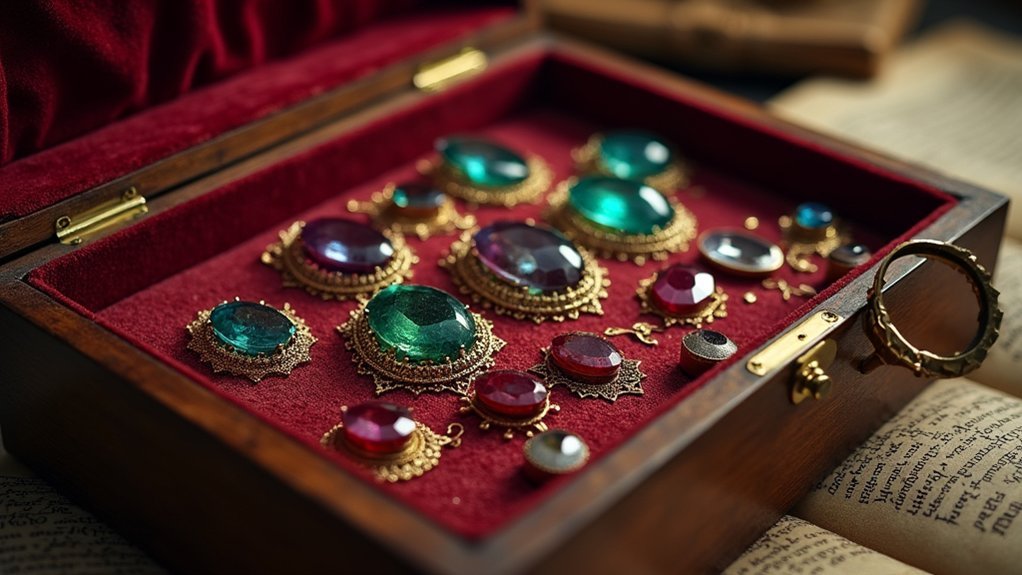



Leave a Reply